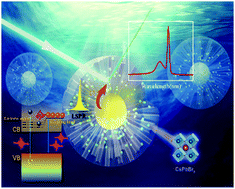Low-threshold stimulated emission in perovskite quantum dots: single-exciton optical gain induced by surface plasmon polaritons at room temperature†
Abstract
Colloidal perovskite quantum dots are candidate materials for solution-processable lasers, although stimulated emission in a semiconductor usually occurs in the multiexciton regime. Due to the quantum-confinement effect of semiconductor quantum dots, the non-radiative recombination transition dominates the relaxation of multiexcitons. Hence, the implementation of low-threshold stimulated emission of perovskite quantum dots in the single-exciton regime is meaningful. Herein, we show that this problem can be partially solved by employing a locally enhanced electric field. By applying the metal surface plasmon resonance energy-transfer effect, we demonstrate a considerable reduction of the optical gain threshold due to the newly generated coupling level induced by the local surface plasmon, and obtain optical gain in the single-exciton regime at room temperature in colloidal perovskite quantum dots. At the same time, we achieve a more than fourfold reduction in the amplified spontaneous emission threshold. This may provide a new concept for the further design of low-threshold stimulated emission colloidal nanocrystal lasers and even for improving their energy conversion efficiency.



 Please wait while we load your content...
Please wait while we load your content...